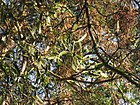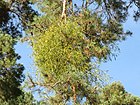Note: This is a project under development. The articles on this wiki are just being initiated and broadly incomplete. You can Help creating new pages.
Difference between revisions of "Viscum album - Mistletoe"
(→Uses) |
(→References) |
||
| (One intermediate revision by the same user not shown) | |||
| Line 39: | Line 39: | ||
===Flower=== | ===Flower=== | ||
| − | {{Flower|Unisexual|2-4cm long|Yellow|5-20| | + | {{Flower|Unisexual|2-4cm long|Yellow|5-20|Mistletoe is dioecious meaning male and female flowers are produced on separate plants}} |
===Fruit=== | ===Fruit=== | ||
| Line 79: | Line 79: | ||
<references> | <references> | ||
| − | <ref name="chemical composition">[https://www.sigmaaldrich.com/life-science/nutrition-research/learning-center/plant-profiler/viscum-album.html | + | <ref name="chemical composition">[https://www.sigmaaldrich.com/life-science/nutrition-research/learning-center/plant-profiler/viscum-album.html Chemical constituents]</ref> |
| − | <ref name="Leaf">[https://www.woodlandtrust.org.uk/visiting-woods/trees-woods-and-wildlife/plants-and-fungi/woodland-wildflowers/mistletoe/ | + | <ref name="Leaf">[https://www.woodlandtrust.org.uk/visiting-woods/trees-woods-and-wildlife/plants-and-fungi/woodland-wildflowers/mistletoe/ Plant description]</ref> |
| − | <ref name="How to plant/cultivate">[https://www.pfaf.org/user/Plant.aspx?LatinName=Viscum+album | + | <ref name="How to plant/cultivate">[https://www.pfaf.org/user/Plant.aspx?LatinName=Viscum+album Cultivation details]</ref> |
</references> | </references> | ||
Latest revision as of 18:08, 2 September 2020
Viscum album is a species of mistletoe in the family Santalaceae, commonly known as European mistletoe, common mistletoe or simply as mistletoe. It is native to Europe and western and southern Asia.
Contents
- 1 Uses
- 2 Parts Used
- 3 Chemical Composition
- 4 Common names
- 5 Properties
- 6 Habit
- 7 Identification
- 8 List of Ayurvedic medicine in which the herb is used
- 9 Where to get the saplings
- 10 Mode of Propagation
- 11 How to plant/cultivate
- 12 Commonly seen growing in areas
- 13 Photo Gallery
- 14 References
- 15 External Links
Uses
Breast cancer, Internal bleeding, Hemorrhoids, Gout, Headache, Whooping cough, Asthma, Diarrhea, Dizziness
Parts Used
Chemical Composition
Plant proteins with high affinity to specific cellular glycoconjugates: Lectin I (D-galactose-and N-acetyl-D-galactosamine, and sialoglycoproteins specific lectin)37,38,39,40,41, Lectin II and III (N-acetyl-D-galactosamine specific proteins).[1]
Common names
| Language | Common name |
|---|---|
| Kannada | |
| Hindi | |
| Malayalam | |
| Tamil | |
| Telugu | |
| Marathi | NA |
| Gujarathi | NA |
| Punjabi | NA |
| Kashmiri | NA |
| Sanskrit | |
| English | Common Mistletoe, European mistletoe |
Properties
Reference: Dravya - Substance, Rasa - Taste, Guna - Qualities, Veerya - Potency, Vipaka - Post-digesion effect, Karma - Pharmacological activity, Prabhava - Therepeutics.
Dravya
Rasa
Tikta (Bitter), Kashaya (Astringent)
Guna
Laghu (Light), Ruksha (Dry), Tikshna (Sharp)
Veerya
Ushna (Hot)
Vipaka
Katu (Pungent)
Karma
Kapha, Vata
Prabhava
Habit
Identification
Leaf
| Kind | Shape | Feature |
|---|---|---|
| Simple | Alteranate | Pairs of oval green leaves |
Flower
| Type | Size | Color and composition | Stamen | More information |
|---|---|---|---|---|
| Unisexual | 2-4cm long | Yellow | 5-20 | Mistletoe is dioecious meaning male and female flowers are produced on separate plants |
Fruit
| Type | Size | Mass | Appearance | Seeds | More information |
|---|---|---|---|---|---|
| General | 7–10 mm | Waxy white berries in clusters of two to six | With hooked hairs | - | {{{6}}} |
Other features
List of Ayurvedic medicine in which the herb is used
Where to get the saplings
Mode of Propagation
How to plant/cultivate
A parasitic plant, growing on the branches of several deciduous species of trees. It is not usually found on coniferous trees, though the subspecies V.[3]
Commonly seen growing in areas
Grows on the branches of many trees, Especially on calcareous soils, On poplars.
Photo Gallery
References
External Links
- Ayurvedic Herbs known to be helpful to treat Breast cancer
- Ayurvedic Herbs known to be helpful to treat Internal bleeding
- Ayurvedic Herbs known to be helpful to treat Hemorrhoids
- Ayurvedic Herbs known to be helpful to treat Gout
- Ayurvedic Herbs known to be helpful to treat Headache
- Ayurvedic Herbs known to be helpful to treat Whooping cough
- Ayurvedic Herbs known to be helpful to treat Asthma
- Ayurvedic Herbs known to be helpful to treat Diarrhea
- Ayurvedic Herbs known to be helpful to treat Dizziness
- Herbs with Stem used in medicine
- Herbs with Leaves used in medicine
- Herbs with common name in English
- Habit - Parasitic shrub
- Index of Plants which can be propagated by Seeds
- Index of Plants which can be propagated by Cuttings
- Herbs that are commonly seen in the region of Grows on the branches of many trees
- Herbs that are commonly seen in the region of Especially on calcareous soils
- Herbs that are commonly seen in the region of On poplars
- Herbs
- Santalaceae





